You load sixteen tons . . . what do you get?
Another day older and deeper in debt
Saint Peter don’t you call me ’cause I can’t go
I owe my soul to the company store – by: Merle Travis
“There was an old saying around the coal mines in the Depression days. Somebody’d say, “How you doing?” . . . And he’d say, “Well, alright, I guess. I can’t afford to die, because I owe my soul to the company store.” I wrote the song Sixteen Tons around that saying.” Merle Travis
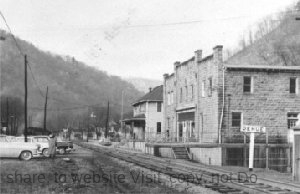 DEHUE COMPANY STORE
DEHUE COMPANY STORE
The Dehue Company Store was built in 1917 by Robert Jennings Frazier. The natural stone was hewn out of the mountain.
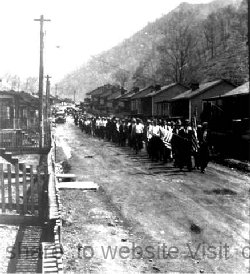 DEHUE MINERS
DEHUE MINERS
Dehue miners march down the “big hill” on the unpaved street during the organization of the union in 1934. By the mid 1940’s the street had been paved, and I was in grade school. The “big hill” was a favorite gathering place in the winter, and we loved zooming down that hill on our sleds. Few people owned cars back then, so it was a safe place to play. However, when some of the kids got creative and poured pails of water on the hill at night to keep the hill slick for the next day, the Company caught up with them and put a stop to it.
COAL MININ’ MAN
Daylight or dark
In rain or shine
It don’t matter
Down in the mines
Where the tunnel is deep
Lord the air gets thin
That’s the way of life
for the minin’ man
His lungs are weak
His back is gone
His sixty years
Are plainly shown
Lived half his life
Down in the ground
A cold steel hammer
Rings a mournful sound
I’ll tell you son
He said to me
There’s just two things
I pray to see
That’s the day my Savior
Calls me Home
And to see my son
stop minin’ coal
Oh Daddy dear
I’ll tell you true
There’s nothing else
For me to do
But to make my livin’
Underneath this land
And live and die
A coal minin’ man
Written by Jim Mills after being inspired by watching a PBS documentary on Eastern Kentucky Coal Mines. The song is a beautiful haunting bluegrass tune recently recorded by Ricky Scaggs on his CD Ancient Tunes. My dad often told me he loved being a miner. However, neither he or my father-in-law wanted their sons following in their footsteps. They didn’t. By the late sixties Logan County miners were facing hard times, and by 1980 more than half of them were out of work. The sons who might have considered mining as a career had long since migrated to large cities seeking employment.
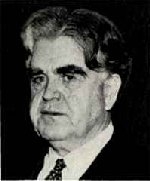 JOHN L. LEWIS
JOHN L. LEWIS
John L. Lewis was born in Lucas, Iowa, February 12, 1880, and became the most recognized leader of the United Mine Workers of America. He was the son of a Welsh coal miner who was also a union organizer. Lewis’ formal education ended in the eighth grade when he went to work to help support his family. However, due to the influence of his mother and later his wife, Myrta, a school teacher, he read widely. The bushy eye-browed leader of the UMWA often quoted Shakespeare, and became one of the most eloquent speakers of his time. In 1937 the New York Times devoted approximately one-twentieth of their local news coverage that year to John L. Lewis. He received more coverage than the Yankees, Dodgers, and Giants combined. Even popular President Franklin Delano Roosevelt did not get as much press coverage as Lewis did. He retired in 1960 after holding the office of president of the UMWA for forty years.
THE MOUNTAIN STATE
Almost all West Virginians were born in the United States, but many of their ancestors came from Spain, Germany, Great Britain, Hungary, Ireland, Italy, and Poland. They came to West Virginia in the late 1800’s and early 1900’s to work in the coal mines.
West Virginia has no large areas of level ground except for strips of valley land on along rivers. The Appalachian Mountains cover many sections of the state giving it the nickname of the”Mountain State.” Coal made millionaires out of many men, but strangely enough most of those men lived in other states. More foreign born have died in West Virginia mine disasters than American born. It is not considered a mine disaster unless five or more men die.
The miners joined the United Miner Workers of America in the early 1900’s, and under union president John L. Lewis the union experienced its greatest growth. The union fought for better safety, wages, and health benefits, but not without bloodshed. Today mining accidents have declined dramatically, as a result of research, technology, education, and preventive programs. However, many of the once booming mines have closed their doors forever leaving in their wake many widows and fatherless children. By the early eighties, the bottom had dropped out of the mining industry. The Collapse of oil prices took a sudden dive, and a federal law was repealed prohibiting construction of new oil or natural-gas-fired electricity plants. The EPA demanded cleaner air and water. It was then that more than half of Logan County’s miners became jobless.
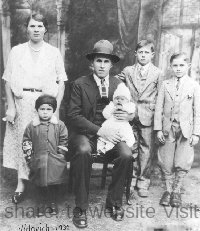 FRANK & BARBARA VIDOVICH
FRANK & BARBARA VIDOVICH
CHILDREN: JUDY, ROBERT, VICTOR, & BRONK
Frank brought his family to Logan from North Carolina in 1930. He was employed at Dehue from 1939 until his retirement in 1978. Bronk gave me this lovely picture at the 1999 Dehue Reunion. Bronk met his wife, Margaret Kalich, at Dehue, and also worked at Dehue Mine. Margaret worked for six years at the Dehue Company store. They have a son, David, and they live near Chapmanville.
I’M A UNION MAN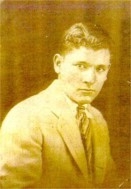 A YOUNG GABRIEL CANELLAS
A YOUNG GABRIEL CANELLAS
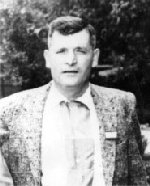 GABRIEL CANELLAS SHORTLY BEFORE HIS DEATH
GABRIEL CANELLAS SHORTLY BEFORE HIS DEATH
Gabriel Canellas’ wife, Agnes said in the mid-thirties, her brother, Jim Biggs was taken-off to jail on trumped up charges on election day to keep him from voting. Dr. Vaughn was the company doctor at the time, and he bailed Jim out of jail. Dr. Vaughn then armed himself, and stood outside the voting booth while Jim voted.
Daughter, Francis remembers boxes of half-pint bottles of whiskey stacked to the ceiling on their enclosed back porch. Union members drove voters to the polls and passed out whiskey to buy their votes. Was it illegal? Yes . . . but the union made sure when important issues were on the ballot . . . and the vote was in their favor.
Gabriel’s daughter’s, Joyce and Francis often sat in their daddy’s car at the Logan courthouse square people-watching while their dad politicked for the union. “Dad checked on us often” Francis said. “Each time he checked, he gave us a quarter which we eagerly spent at the dime store across the street. We recall those trips to town with great affection.”
Gabriel was financial secretary of Dehue Local Union 5869 – District 17 when he died enroute to the hospital on March 30, 1959. Gabriel was from Spain. He was born in the small village of Santa Eugenia on the Island of Mallorca.
I’m a mountain man . . . born in east Kentucky . . .
. . . And here I’ll stay. . . . It’s the good Lord’s plan.
I’m a union man . . . just like my dad and all my kin.
Took a union stand . . . no matter what the Company said.
A verse from the song Harlan Man by Steve Earle and The Del McCoury Band. Miners from eastern Kentucky and southern West Virginia were some of the strongest union supporters.
 PRESIDENT FRANKLIN DELANO ROOSEVELT
PRESIDENT FRANKLIN DELANO ROOSEVELT
The miners put John L. Lewis, and President Franklin Delano Roosevelt right up there with God. Lewis obtained health and retirement benefits, Roosevelt’s New Deal made available jobs during the Great Depression . . . and faith in God got the miners through many hard times.
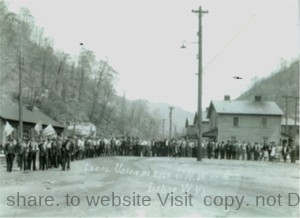 KENTUCKY ROW
KENTUCKY ROW
Dehue UMWA Local No. 5869 coal miners, and some of their spouses gather in front of the lamphouse on April 23, 1935. The fan that pulled air into the mine looms in the background. To the right is Kentucky Row which got its name because so many miners from Kentucky lived in that row of double-houses. Our family lived in house number 88 which is the end house from 1958 to 1966. Bernie Brumfield, the first president of the local, holds the third flag from the left.
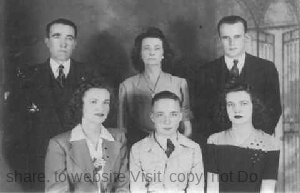 THE BERNIE BRUMFIELD FAMILY
THE BERNIE BRUMFIELD FAMILY
back row: Bernie, Sr., Sina, Eugene. front row: Jewel, Bernie, Jr., Freda
 DEHUE SHOP EMPLOYEES
DEHUE SHOP EMPLOYEES
The fifteen shop employees of the Youngstown Mine at Dehue topped their own safety record in 1968 of 282 days by working 800 days without an accident. Pictured are front row: Wilson Hinchman, Fred Lewis, Clyde Simmons, Basil Frye. Back row: James Robinson, John Coleman, Edward Flemings, Jimmy Alexander, Keith Ingram, Walter Martin, Ward Ferrell. Absent when picture was taken: Estel Murray, Mike Gostovich, Clyde Woolcock, Willard Craft.
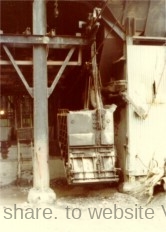 THE BUCKET THAT CARRIED SLAG TO THE MOUNTAINSIDE SLATE DUMP HAS BEEN SILENCED FOREVER.
THE BUCKET THAT CARRIED SLAG TO THE MOUNTAINSIDE SLATE DUMP HAS BEEN SILENCED FOREVER.
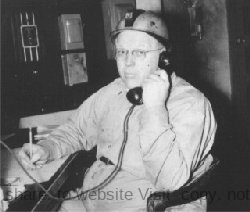 EDWARD BROWNING – 1956
EDWARD BROWNING – 1956
Edward was underground dispatcher and directed traffic inside the Dehue Mine from his desk.
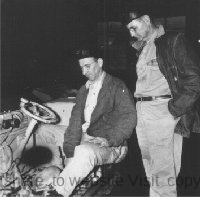 STANLEY HOPECK & TOM SMALLWOOD
STANLEY HOPECK & TOM SMALLWOOD
In 1956 night foreman, Stanley Hopeck demonstrated to master mechanic, Tom Smallwood how a revolving seat on an underground shuttle worked. The seat was developed by Dehue, and permitted operators to change positions and face in the direction the shuttle car traveled.
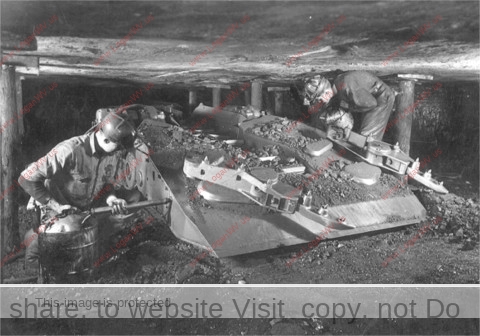 RAYMOND SIMMONS
RAYMOND SIMMONS
Raymond Simmons (on left) working inside the Dehue Mine. Raymond died at age 41 in a mine accident at the Orville Paragon Mine on December 28, 1948. He was riding in a trip of empty cars when a loaded trip coming in the opposite direction went out of control and crushed him to death. Simmons death raised Logan County’s death toll in mine accidents to forty for the year.He was survived by his wife, Faye Adkins Simmons, and daughters Mary Lou and Norma Sue. Services were held at the Dehue Community Church with Rev. Jeff Curry officiating. Harris Funeral Home was in charge of arrangements, and burial was at Logan Memorial Park in McConnell.
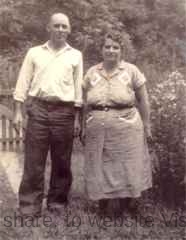 Johnnie Frye (1902-1977) and Grace Bell Artist-Frye (1900-1995)
Johnnie Frye (1902-1977) and Grace Bell Artist-Frye (1900-1995)
SAVED BY GRACE
by: Geraldine Frye-Hager
My father, Johnnie Frye was born in Boone County at Lake, West Virginia on Hewett Creek. As a young lad, he helped his father on the farm. He was twelve when WW I broke out, and was too young to join the army. So at an early age he delivered the US Mail on horseback. In 1921 he went to work in the mines. At that time, ponies were used to pull wagons loaded with coal to the surface. Canaries were kept in cages to send into the mine to check for deadly gas. If the canary lived, it was a signal that it was safe to enter the mine.
My mother, Grace Bell Artist was born in Carter County at Hitchens, KY to William Henry and Maggie Hensley-Artist. Grandmother died in 1910 at age thirty eight of complications six weeks after giving birth to a stillborn child. It fell upon my ten-year-old Mother as the eldest female child to care for three older brothers, a younger sister and brother. It was a heavy burden at such a young age to take care of the house, her father and all of her siblings. Her childhood was over with no time to grieve for her mother. She quickly learned what hard work was all about, and how to “take-up” for herself to survive. She married at age at age sixteen, and had four children of her own. They were named Hattie Mae, Earl Eugene, Geraldine (me), and Robert.
At the end of WW I in 1918 the Spanish Flu epidemic caused the death of people worldwide. Many people who seemed to be healthy in the morning were dead by sundown. There was no rhyme or reason to those who fell victims to that horrible flu. Mother lost a baby boy to the flu outbreak. In almost every household a loved-one was lost. So many died there was a shortage of coffins. When a family was struck down they relied on help from others. Mother ignored quarantine signs to care for entire families especially when a wife or mother left their loved-ones to grace Heaven’s door. God was merciful, and spared mother from falling victim to that awful flu. Again, she was a survivor.
By the beginning of WW II in 1941, mining had changed significantly and dad became a machine operator for Hutchinson Coal Company at the MacBeth mine. Dad’s brother, and my Uncle, Joe Fry was killed in MacBeth’s 1937 explosion. Dad worked thirty-six years in deep, dark, dank holes in the ground. Many times he went to work before sunup and came home after sundown never seeing daylight for weeks. My heart ached to watch him walk toward the tipple with his lunch pail in his hand. He gave years to the Company, and we worried every time he went to work until he returned home safely. He risk his life each time he went down in that hole, and when payday came he owned more than he made for the pay period. In order to feed our family Mom drew scrip toward dad’s pay, and bought food at the over-priced company store. It was indeed a form of slave labor. However, during the depression years you were lucky to have a job. Mining coal was a way for his family to survive.
Mother put her shoulder to the wheel of many a heavy load in that coal camp just like she did when her mother died. She was used to hard work and thrived on never turning anyone in need away. She cared not if they were the superintendent of the mine, a foreman, or one of dad’s co-workers. The Colored and well as the White families knew they could always “Go see Grace” in time of need.
Mother and daddy worked hard in their oversized garden which made it flourish enough to share with their neighbors. Her pantry was always full of home-canned jars of raspberry/blackberry jams and jellies and “pickled” beans and corn. In every coal company house we lived in Mother grew beautiful flowers in our yard when in most of the yards grass wouldn’t even grown in the coal dirt soil. She made the world’s best bacon, eggs, and biscuits for breakfast. I can almost taste the sorghum we smeared on those biscuits. She did it all on a wood burning cookstove. I can close my eyes and see her shuffle skillets around on that old stove, and she knew just when to stoke the fire just a bit more to make everything turn out just right.
Dr. Vaughn and Dr. Brammer were the company doctors, and many times in the middle of a cold winter night they called on her to help out when God was about to breathe life into a new soul. She took “sickly” babies home to nurse them until they could be returned to their grateful mothers. First-time mothers were always thankful when she was there to lend a hand. “Saved by Grace” had more than one meaning to her neighbors.
Dad retired in1957, and they are still loved and remembered by friends and family whose lives they touched in some small way. While daddy mined the coal from those deep holes in the ground Mother mined the welfare of her neighbors. The pressures of a hard life produced two beautiful diamonds out of the black dust of Logan County, WV. They were true survivors.
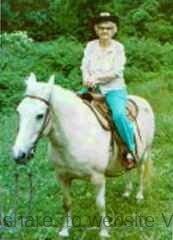 At age 80 Grace still hadn’t lost her spunk
At age 80 Grace still hadn’t lost her spunk
Mine Safety and Health Administration
To visit historical mining disaster pictures click on the link above. Then go to Mining Disaster Exhibition. Jane DeMarchi of the Beckley (MSHA) Mine Safety and Health Administration collected and organized the pictures. The Dehue Exhibit is permanently housed at the MSHA office.
Visit a WV GenWeb Special Project link hosted by Gracie Stover. Gracie is from Raleigh Countyand does a wonderful job of documenting coal mining history.

Thanks for a very informative well
written story. Hope more people
will read it. If I had Facebook I
would post it there.